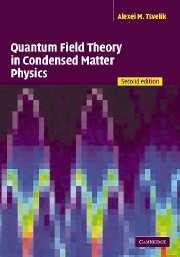Book contents
- Frontmatter
- Contents
- Preface to the first edition
- Preface to the second edition
- Acknowledgements for the first edition
- Acknowledgements for the second edition
- I Introduction to methods
- II Fermions
- III Strongly fluctuating spin systems
- Introduction
- 16 Schwinger–Wigner quantization procedure: nonlinear sigma models
- 17 O(3) nonlinear sigma model in (2 + 1) dimensions: the phase diagram
- 18 Order from disorder
- 19 Jordan–Wigner transformation for spin S = 1/2 models in D = 1, 2, 3
- 20 Majorana representation for spin S = 1/2 magnets: relationship to Z2 lattice gauge theories
- 21 Path integral representations for a doped antiferromagnet
- IV Physics in the world of one spatial dimension
- Select bibliography
- Index
Introduction
Published online by Cambridge University Press: 05 May 2010
- Frontmatter
- Contents
- Preface to the first edition
- Preface to the second edition
- Acknowledgements for the first edition
- Acknowledgements for the second edition
- I Introduction to methods
- II Fermions
- III Strongly fluctuating spin systems
- Introduction
- 16 Schwinger–Wigner quantization procedure: nonlinear sigma models
- 17 O(3) nonlinear sigma model in (2 + 1) dimensions: the phase diagram
- 18 Order from disorder
- 19 Jordan–Wigner transformation for spin S = 1/2 models in D = 1, 2, 3
- 20 Majorana representation for spin S = 1/2 magnets: relationship to Z2 lattice gauge theories
- 21 Path integral representations for a doped antiferromagnet
- IV Physics in the world of one spatial dimension
- Select bibliography
- Index
Summary
One of the fundamentally nonlinear problems we have not yet discussed is the problem of interacting quantum spins. The nonlinearity is embedded in the commutation relations of spin operators; in contrast with Bose or Fermi creation and annihilation operators, commutators of spin operators are not c-numbers, but are still operators. Therefore even apparently very simple spin models, such as the Heisenberg model, for which the Hamiltonian is quadratic in spins, may exhibit complicated dynamics. In fact the Heisenberg model describes the majority of phenomena occurring in magnets, such as various types of magnetic ordering, spin-glass transitions, etc. In the traditional approaches spins are treated as almost classical arrows weakly fluctuating around some fixed reference frame. This reference frame is defined by the existing global magnetic order. For example, in ferromagnets or antiferromagnets, where the global order specifies only one preferential direction (the direction of average magnetization or staggered magnetization), it is supposed that spins fluctuate weakly around this direction. In helimagnets there are two preferential directions describing a spiral; their spins fluctuate around the spiral configuration. When deviations of spins from average positions are small, the spin operators can be approximated by Bose creation and annihilation operators. This approach is called the spin-wave approximation. As I have already said, it is based on two assumptions: existence of a global reference frame and smallness of fluctuations. Difficulties arise when fluctuations become strong and destroy the global order.
In this part of the book I will primarily discuss disordered magnetic systems. However, I shall not touch on such complicated sources of disorder as quenched randomness.
- Type
- Chapter
- Information
- Quantum Field Theory in Condensed Matter Physics , pp. 143 - 147Publisher: Cambridge University PressPrint publication year: 2003



